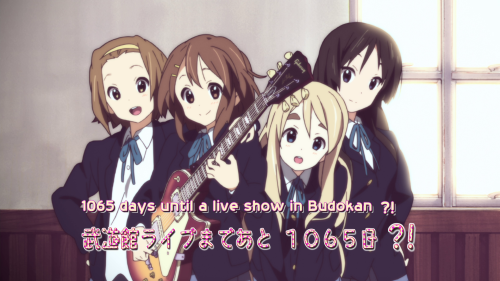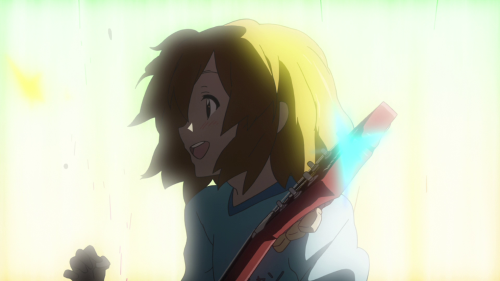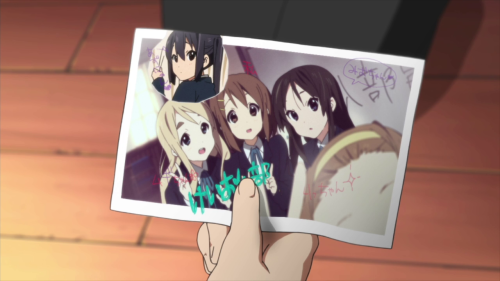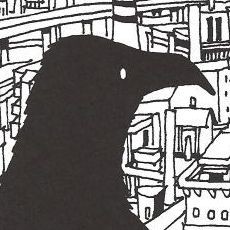All these years, I wanted K-On! to prove me right. I wanted it to be a shitty anime about cute girls doing cute things. I wanted to hold myself above it and I wanted you all to point and look and say “Look at those folks over at Bateszi Anime Blog, they have such good fucking taste, they’d never blog about K-On! because it’s moe-moe shit!”

K-On!, an anime ostensibly about cute high school girls forming the next world-shattering rock band, ends its 2nd episode ends with a dubiously punctuated countdown. The countdown records the 1000-odd days the girls have to achieve their lofty dream of playing in Japan’s national stadium, the Budoukan, before they graduate. Perhaps the most jarring part about watching K-On! for me, with all my preconceptions, was that the show had me from this moment on. As soon as I saw the countdown I knew I was watching for keeps; that I had to see the girls through to their dream, or wherever they ended up instead.
If this were any other anime, playing the Budoukan would actually be an attainable goal, and something its characters visibly worked towards each episode. The long-since gone anime blog Iwa Ni Hana once mentioned that at the core of all anime (and indeed, all Japanese culture) is the spirit of ganbaru, translated, “to try one’s hardest”. However K-On! isn’t every other anime, and perhaps embodies a more modern, honest take on the spirit of ganbaru. The light music club seems to take great pleasure in doing all it can to not play music; spending their after school time lazily drinking tea and eating cakes instead. In its second season, comparisons are constantly drawn to the hardworking and musically talented jazz club and the lackadaisical light music club.
But, like Azusa, the earnest and solitary underclassmen of the light music club, even though I knew the light music club would never play the Budoukan as they so boldly proclaimed I still kept watching. I watched as their Budoukan dream was quickly forgotten, and as the seasons seemed to tumble into one another all too quickly. Shouldn’t they start practicing now? I’d ask myself. Do they even remember what they said, on the club’s inception? I pondered. The question I was really asking, of course, is whether they’d ever make their dreams into a goal.

We had glimpses of the dream, of course. The music video hallucinations the animators provide us during performances. The girls playing at a live house in the OVA. Yui, jubilant in front of a row of roman candles, pretending to be the rock star they foolhardily aimed towards. It was as if the Budoukan was always right around the corner, always one more big push away. If they’d just practice more, or focus on writing better lyrics, the ball would start rolling down the hill, and before we knew it, we’d be there.
And then, quickly as it all started, the girls were in their last semester of their last year of high school. Somewhere along the line, the girls had traded their dream of the Budoukan for college exams, and music video dreams for imaginings of their future careers. Suddenly, everyone was graduating, and high school was nothing but a collection of photographs.

And though K-On! was definitely the moe-moe show of cute girls doing cute things that I expected it to be, it wasn’t shitty, and I was sadder than I thought I’d be when it was all over. The girls dreaming of Budoukan wasn’t abnormal: who hasn’t dreamed of becoming a rock star, or an astronaut, or a president. What’s abnormal would have been if they’d actually succeeded. Ultimately lots of someones need to become the quiet office workers in normal companies dotting the globe, the housewives, and the secretaries. Not everyone is suited for the road to the top, but even the most average of us dreams of the path.
All good dreamers pass this way
6 responses to “All good dreamers pass this way”
-
Honestly, I think that K-ON! gets a much worse rap among the anime community than it deserves. The first season is fun (though a little disposable) but once it hits the second season I was struck how the tenor of the story changed from happy moe fun times to something more elegiac. It’s a show that’s totally fine devoting an episode to side characters while the protagonists are on a field trip, or luring you into a false sense of security and then kicking you in the mono no aware. I have yet to finish the second season but I intend to someday!
Honestly, I’d be okay with the oncoming Moe Apocalypse if the results were anywhere near as good as K-ON!! KyoAni rarely pick the most ambitious premises, but their execution is 100%.-
K-on’s quality, and the unique popularity that resulted from it, are exactly the reasons why it’s getting a bad rap.
There were many similar shows for years before K-on, and they missed the focus of interest of both our community, and the Japanese DVD buyers. K-on is special because it was suddenly popular in both, so it could be conveniently pushed into the role of the Harbringer of the Moe Apocalypse, that single-handedly explains all the other (unpopular, unsuccessful) Iyashikei series as an ominous trend, instead of just a niche that is about as big as shoujo romances or mecha series. -
I think, with K-On!, it was very symbolic of a time and a place. There was definitely a shift in the kinds of anime which were getting produced and becoming popular, and between Haruhi in 2006 and K-on! in 2009 Kyoto Animation was really changing the landscape of anime.
In a way, Kyoto Animation is probably the second vanguard of anime fandom in the west (with the first being from 1988’s Akira, moving through Evangelion and Cowboy Bebop in the late 90s, and tapering off in the first half of the 2000’s). Whereas the old guard of anime was characterized by a distinct grittiness (baring resemblance to the 1990s grunge movement, if anything) and a maturity of plot – and, most importantly, a distinctly shounen/seinen attitude – the new guard of KyoAni moe stuff was almost entirely counter to that, both in terms of art style and subject matter.
K-on! (and to a lesser extent, due to its rabid fanbase, Haruhi) became a figurehead of this shift, and me, like many people of the ‘old guard’ of anime fandom found it initially quite repulsive. It was hard not to: K-on! was counter to everything we thought anime was or should be.
That said, it’s 2013, and the moe battle has been fought and lost on our part. Moreover, the moe ‘genre’ could be said to be evolving, with Kyoto Animation leading this push, producing series like Hyouka and (as I understand, to an extent) Tamako Market, which break the very rigid rules of moe they set out for themselves.
Much like the cyclic nature of pop and rock in holding the cultural zeitgeist, I think anime follows a similar pattern, by which ‘harder’ series and ‘softer’ ones become popular in roughly 10-year cycles.
In conclusion: yes, I think it gets a bad rap in the community amongst older fans in particular.
-
-
While I think your points in the comments here are relevant, I always feel like my dislike for K-ON is painted as something temporal or prejudiced. I like anime, and I have no interest in being prejudiced if it’s going to make me miss a cartoon. Although Haruhi was probably really influential in the worst way, the show itself was great. Hell, Evangelion started us down Moe Road, much as older fans might want to forget that.
My issue was that I couldn’t stay awake through an entire episode of the first season. I watched 6 of them, and never quite felt engaged. Not sure what it is — I like far slower shows like Aria just fine. But it never clicked with me.
A lot of people other than you have mentioned the tonal shift of the second season (ghostlightning used to tell me how much more engaging and emotionally charged it was), and that has intrigued me. But I think part of its effect requires an investment that you get from the first season, and I just never felt it. That bums me out because I probably won’t ever get “the feels” from K-ON that so many people seemed to enjoy.-
In my opinion, the tonal shift of in K-on’s second season wasn’t as pronounced as many people seem to think. Maybe it felt that way to me though because I marathoned it, and knew at the end that they’d be graduating quietly. That said, I wonder if anyone ever had any expectations for the show to go in a different direction? I never did. In my mind, it was fairly clear from the get-go that the series would be ending upon the girls’ graduation.
I guess what I’m trying to say is I didn’t so much get ‘the feels’ near the end of the series, so much as it ended the way I thought it would, and was simple and realistic (which is sad within itself, I suppose).
-
-
You touch on a very very interesting subject here Celeste. The new kids on the block “Moe shows” have come out of nowhere to take over the anime medium, replacing the more “adult” shows.
That in a nutshell echoes how I felt once, heck I still feel like that sometimes. But things definitely have changed once I gave Hyouka a chance as it was way too subtle and sublime for a “Moe” show. K-on’s first season, although fun to an extent, did not push me to watch the second season which I hear is a vast improvement.
Even with shows like Hyouka having a positive effect on us older fans of anime, not all studios have talent and production quality of the likes of Kyoto Animation. If other less capable studios decided to bank all their resources on moe shows that would definitely be a sad sad day, as not all studios have the exquisite art and animation of Kyoani to fall back on.
I know I barely touched on K-on in this comment, but I just had to share my thoughts on this troubled industry, albeit one we all still love 🙂

Leave a Reply